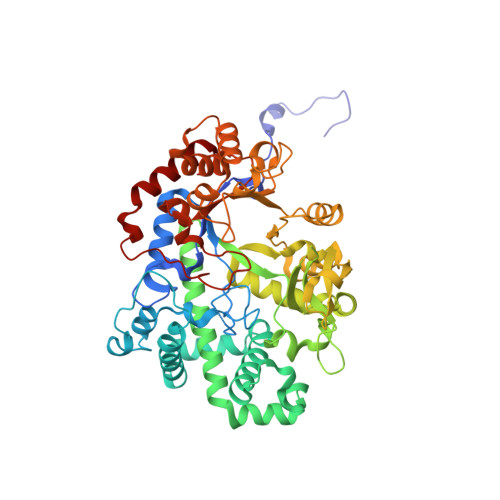Structural analysis and reaction mechanism of the disproportionating enzyme (D-enzyme) from potato.
Imamura, K., Matsuura, T., Nakagawa, A., Kitamura, S., Kusunoki, M., Takaha, T., Unno, H.(2020) Protein Sci 29: 2085-2100
- PubMed: 32808707
- DOI: https://doi.org/10.1002/pro.3932
- Primary Citation of Related Structures:
6LX1, 6LX2, 7COV - PubMed Abstract:
Starch produced by plants is a stored form of energy and is an important dietary source of calories for humans and domestic animals. Disproportionating enzyme (D-enzyme) catalyzes intramolecular and intermolecular transglycosylation reactions of α-1, 4-glucan. D-enzyme is essential in starch metabolism in the potato. We present the crystal structures of potato D-enzyme, including two different types of complex structures: a primary Michaelis complex (substrate binding mode) for 26-meric cycloamylose (CA26) and a covalent intermediate for acarbose. Our study revealed that the acarbose and CA26 reactions catalyzed by potato D-enzyme involve the formation of a covalent intermediate with the donor substrate. HPAEC of reaction substrates and products revealed the activity of the potato D-enzyme on acarbose and CA26 as donor substrates. The structural and chromatography analyses provide insight into the mechanism of the coupling reaction of CA and glucose catalyzed by the potato D-enzyme. The enzymatic reaction mechanism does not involve residual hydrolysis. This could be particularly useful in preventing unnecessary starch degradation leading to reduced crop productivity. Optimization of this mechanism would be important for improvements of starch storage and productivity in crops.
- Laboratory of Enzyme Chemistry, Graduate School of Agriculture and Biological Science, Osaka Prefecture University, Osaka, Japan.
Organizational Affiliation:



















